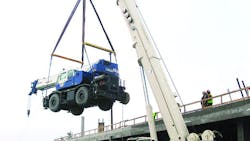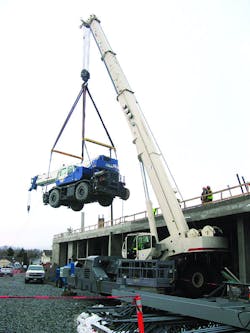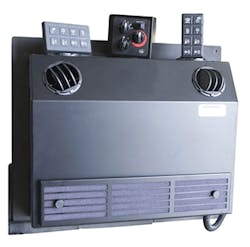Hydraulics Powers Off-Road HVAC System
Like today’s automobiles, the cabs of modern off-road equipment are climate-controlled. After all, a comfortable operator is more productive. Unlike automotive heaters, some off-highway vehicles have red-hot electrical resistance or diesel or propane fuel fired heaters. However, many jobsites—particularly petrochemical plants and underground mines—now restrict or prohibit heaters that involve open flames. Some sites even require the removal of the fuel source from these heaters from the machine before it can enter the area.
This file type includes high resolution graphics and schematics when applicable.
Kenway Engineering Inc., Fairmont, Minn., bypasses these restrictions with their 9067 Series flameless HVAC system for off-road mobile equipment. This system is designed to provide comfort heating, air-conditioning, and air filtration for the operator. In many ways, it is similar to an automotive comfort system. It differs in that it is not driven by an engine, but by a hydraulic motor that drives the AC compressor and the hydraulic heat pump.
The heat pump could be driven off a PTO at the engine, but this wastes energy and adds unnecessary working hours to the components. The pump would circulate fluid even when heat is not needed. The Kenway system stops pump rotation with a clutch, which also extends the pump’s service life.
Bring on the heat or keep it cool
A 9067 unit generates heat by pumping hydraulic fluid through a relief valve. When the fluid is dumped from high to lower pressure, no mechanical work is performed and the mechanical energy is converted to heat. The hot fluid then passes through a heat exchanger inside the cab. Air in the cab is drawn through the heat exchanger and heated by the fluid. The fluid then flows back to the pump where a portion of it is exchanged with fluid from the main hydraulic circuit via a case-drain line. (Without this exchange, the fluid in the circuit could break down and start damaging the components.)
The system can be used in series, in parallel, or with a dedicated circuit. (In series and dedicated circuits are the most common.) The system’s hydraulic circuits are designed to protect pump, valves, and seals from damage caused by fluid breakdown as well as any pressure and flow fluctuations. Hydraulic power is only used to heat the cab, so the system has no thermal impact on the main fluid reservoir.
The compact 9067 Series components can be installed as a split system or as a self-contained unit about the size of a small window air-conditioner. The split system consists of a hydraulic drive unit (usually mounted on the superstructure behind the cab) and a blower unit inside the cab. The components are mounted, plumbed, and then charged with refrigerant and hydraulic fluid. The self-contained unit requires a rectangular opening in the cab wall, three hose connections (hydraulic supply, hydraulic return, and case drain), and a single electrical hookup for power and ground. The system has no tanks of propane or diesel fuel and there is no hydraulic reservoir or filter (other than the machine’s) to maintain. This eliminates regularly scheduled service steps for the heater. The AC portion of the system is a standard automotive thermo-expansion valve system (vapor-compression cycle); therefore, a specially trained HVAC technician is not needed to work on it.
Because the Kenway 9067 Series does not rely on engine heat to run an antifreeze/coolant-based HVAC system, the unit works just as well with the cooler-running EPA Tier 4 engines as it does with pre-compliancy engines. The 9067 system can output up to 27,000 BTU per hour at idle. The hydraulic fluid temperature is limited to 205° F.
Older crane HVAC systems suffer from thermodynamic inefficiencies. The compressor might be hidden deep in the engine compartment, while the evaporator and heater core are in the cab. The distance between them calls for multiple hoses, connections, and a hydraulic swivel to transfer the engine coolant and refrigerant from the chassis to the cab. This results in pressure, flow, and temperature changes, which are detrimental to system performance and durability. The Kenway system eliminates these concerns: each component is within a few feet of the others.
Flexible control
The 9067 Series system can be controlled with a PLC. With that arrangement, a keypad allows the operator to select fan speed, mode, and comfort temperature. The PLC will automatically control the temperature in the cab, as well as minimize the effects of the system on other machine functions. The PLC uses inputs from speed, temperature, and pressure sensors and other switches. These inputs tell the PLC how the machine and the system are operating. The control takes the inputs and, through an in-house developed program, determines how to control the outputs. The outputs include signals to the AC and heat clutches, relief valve, and fan-speed control. The program is designed to optimize operator comfort without adversely affecting machine function.
This file type includes high resolution graphics and schematics when applicable.
The PLC has system diagnostic capabilities. Should a system malfunction occur, a diagnostic mode can be entered to provide the service technician with an easy way to test all the inputs and outputs … and quickly address the problem.
For more information, visit kenwayengineering.com, or call 507/238-9051.



